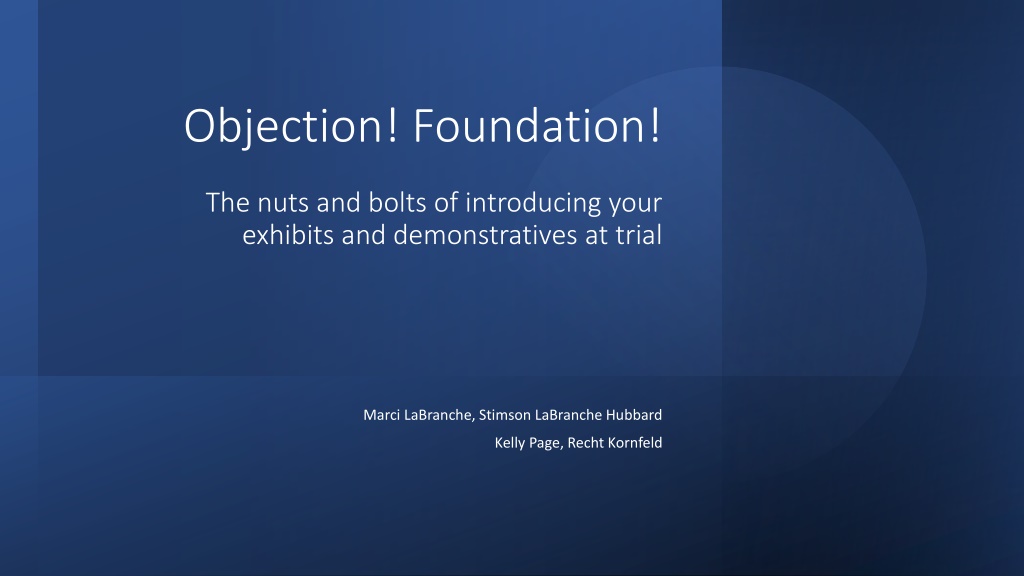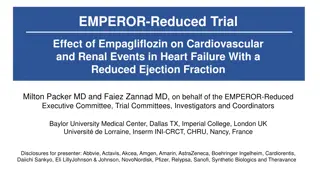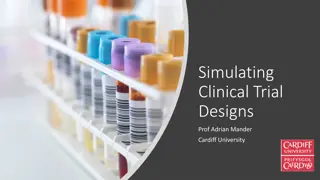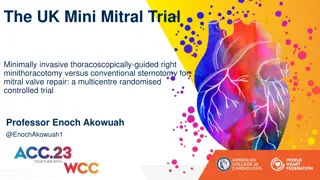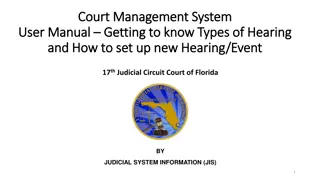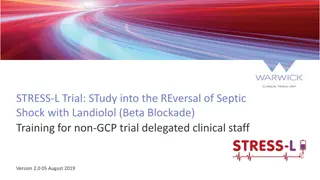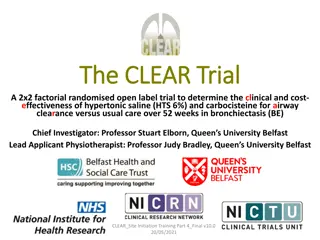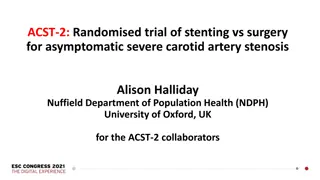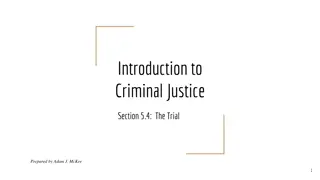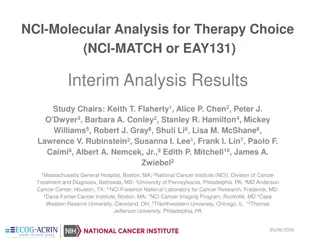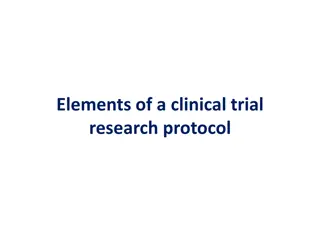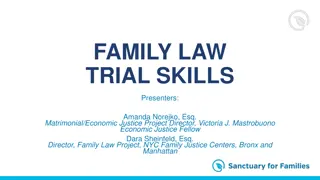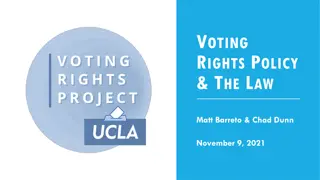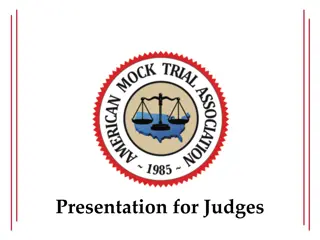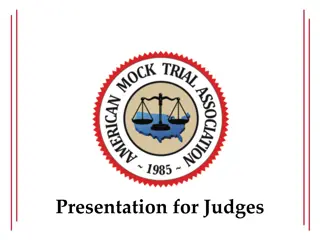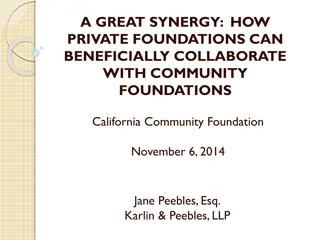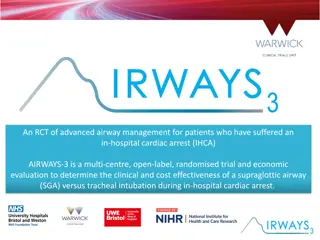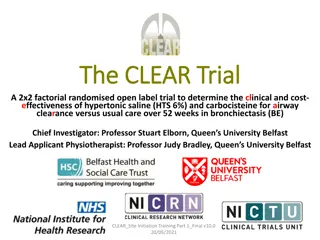Mastering Exhibit Foundations for Trial Success
Unlock the nuts and bolts of introducing exhibits and demonstratives at trial with essential rules of evidence, the importance of laying a foundation, and strategies for preparing and introducing exhibits effectively. Learn about authentication methods, self-authenticating records, and key considerations for presenting photograph exhibits.
Download Presentation

Please find below an Image/Link to download the presentation.
The content on the website is provided AS IS for your information and personal use only. It may not be sold, licensed, or shared on other websites without obtaining consent from the author. Download presentation by click this link. If you encounter any issues during the download, it is possible that the publisher has removed the file from their server.
E N D
Presentation Transcript
Objection! Foundation! The nuts and bolts of introducing your exhibits and demonstratives at trial Marci LaBranche, Stimson LaBranche Hubbard Kelly Page, Recht Kornfeld
Why Do I Need To Lay A Foundation? A foundation is necessary to show that the evidence is authentic, reliable and relevant is required for all exhibits Essentially the who, what, when, where, and why of the exhibit Important rules of evidence for exhibits: FRE 104, 106 FRE 402, 403 FRE 803, 804 FRE 901, 902 Important rules of evidence for demonstratives: FRE 611 FRE 1001
Preparing to Introduce Exhibits at Trial Does the exhibit advance your theory of the case? Do you need you the exhibit to go back to the jury or can it be a demonstrative? When are you introducing the exhibit? Are you going to publish the exhibit? Do you need to litigate its admissibility prior to trial? Build the introduction of the exhibit into your direct/cross/presentation of your case Stipulations with opposing counsel before trial
Question Answer Source Were you on duty the night of the crime? Yes Did you go to the crime scene? Yes Example of Exhibits Built into an Examination Did you take photographs? Yes Your honor, may I approach with what has been marked as Defense Exhibits 300-310.
Who Can Authenticate And How? FRE 901 Testimony of a witness with knowledge Nonexpert opinion about handwriting Comparison by expert witness or trier of fact Distinctive characteristics and the like Recognition of a voice on an audio recording
Self-Authenticating Records FRE 902 (11) Certified Domestic Records of a Regularly Conducted Activity (4) Certified Copies of Public Records. (6) Newspapers and Periodicals. (13) Certified Records Generated by an Electronic Process or System. (14) Certified Data Copied from an Electronic Device, Storage Medium, or File.
Photograph Exhibits Does the witness recognize the photo? How does the witness recognize photo? Does the witnesses know when the photo was taken? Who took the photo? Is the photo a fair and accurate representation of the subject as it appeared at the time?
Video Exhibits that Witness Recorded Did the witness record the incident? When was the video made? Was the witness able to view the video before today? Does the video fairly and accurately depict the scene as it was recorded? Are there any material alterations or deletions to the videos? Don t forget about hearsay issues with these exhibits If there is hearsay, can you just redact as opposed to excluding the whole exhibit?
Audio Recordings FRE 901(5) Has the witness heard Mr. Smith s voice before? Under what circumstances has the witness heard his voice? How many times has the witness heard his voice? Has the witness heard the recording marked as Exhibit X for identification? Does the witness recognize the voice? Whose voice does the witness recognize on the recording?
Authenticating Electronic Records with a Testifying Witness Does the witness s organization use a computer to keep records? Is the computer reliable? Has the organization developed a procedure for inputting data into the computer? Does the procedure have built-in safeguards to ensure accuracy and identify errors? Does the organization keep the computer in a good state of repair? Did the witness have the computer produce a hard copy of certain data? Did the witness use the proper procedures to obtain the hard copy? Was the computer in working order at the time the witness obtained the hard copy? Does the witness recognize the exhibit as the hard copy you produced? How?
Proponent must show that the email is what it purports to be. What does that mean? That it was sent or received by the person claimed to have sent or received it This can be established through various means, such as testimony from the sender or recipient, or technical evidence showing the email s metadata. All methods listed under FRE 901(b) Do not forget hearsay objections and exclusions E-mails and Text Messages
E-mails Are Not Business Records! .the Court finds that the e-mails bear no indicia of accuracy regarding their content within the meaning of the business rule exception. Instead, they consist of typical written conversations between two or more people in the context of running a business. While such conversations may be necessary to the conduct of the business and while their frequency may be regular, the content of the e-mails varies and does not contain information on which the business relies because that content is accurate, as would a bank, for example, in relying upon its deposit records. Therefore, regarding emails that the government seeks to authenticate, the Court will deny the authentication via Rule 902(11). Chief United States District Judge Brimmer in US v. Penn et al Make sure to read United States v. Ary, 518 F3d 775 (10thCir. 2008) and United States v. Snyder, 787 F.2d 1429 (10thCir. 1986)
Social Media Exhibits Need a witness with knowledge Must have distinctive characteristics Establishing authorship: United States v. Brown 834 F.3d 403 (3rdCir. 2016) This includes admission of messages sent through social media like Facebook, Snapchat, Instagram, Tik Tok etc. Best to have recipient of message testifying Be ready for hearsay objections
How to authenticate a like on someone else s Facebook page: 1) First, establish who actually authored the like: o Proponent required to introduce enough evidence such that the jury could reasonably find, by a preponderance of the evidence, that [Defendant] authored the Facebook [like] at issue. o Preponderance of evidence by distinctive characteristics 2) Second, establish relevance and overcome hearsay objections Facebook Facebook Like on Like on Another s Page Another s Page US v. Barela, 2021WL5447915 (D. N.M. 2021)
Government Websites o FRE 902(5) -Official Publications o FRE 803(8) - Public Records Private Websites o Printouts from non-government websites are not self authenticating. o Proponent must present evidence from a witness with personal knowledge of the website at issue stating that the printout accurately reflects the content of the website and the image of the page on the computer at which the printout was made. Print Outs of Websites Toytrackerz LLC, v. Koehler, 2009 WL2591329 (D. Kansas 2009)
Summary Exhibits: FRE 1006 The proponent may use a summary, chart, or calculation to prove the content of voluminous writings, recordings, or photographs that cannot be conveniently examined in court. The proponent must make the originals or duplicates available for examination or copying, or both, by other parties at a reasonable time and place. The court may order the proponent to produce them in court Can be admitted and sent back to the jury MAKE SURE TO ASK FOR A LIMITING INSTRUCTION Cannot be an advocacy piece
Summary Exhibits: FRE 1006 If you re going to create and admit a summary exhibit: 1) Read the case law: United States v. Thompson, 518 F.3d 832 (10thCir. 2008) United States v. Ray, 370 F.3d 1039 (10thCir. 2004) United States v. Renteria, 720 F.3d 1245 (10thCir. 2013) United States v. Brooks, 736 F.3d 921 (10thCir. 2013) 2) Can you meet the two part test for admission: Does the testimony or chart aid the jury in ascertaining the truth? Length of trial, the complexity of the case and the possible confusion generated by exhibits What is the possible prejudice to the defendant/opposing party that may result in allowing such evidence? Is preparer available for cross? Did the court give a limiting instruction? 3) Provide notice to the court and opposing party
Example of a Limiting Instruction During the trial, certain summaries prepared by the government and certain defendants were admitted in evidence because they may assist you in understanding the evidence that has been presented. The summaries themselves are not evidence of the material they summarize and are only as valid and reliable as the underlying material they seek to summarize and are only as valid and reliable as the underlying material they seek to summarize. You may give a summary exhibit entire weight, some weight, or no weight at all depending on your assessment of the underlying material and the accuracy of the summary. Offered and accepted in USA v. Penn
Example of 1006 Summary from US v. Penn
FRE 611(a) Demonstratives CRE 611(a): The court should exercise reasonable control over the mode and order of examining witnesses and presenting evidence so as to make those procedures effective for determining the truth; avoid wasting time; and protect witnesses from harassment or due embarrassment. Does not go back to the jury Not substantive evidence Same caselaw applies GET CREATIVE! Timelines, graphs, pie charts, drawings by a witness on the stand, video recreations
June 17 9:35 PM June 17 10:05 PM June 17 10:52 PM June 18 11:29 AM June 19 12:56 AM Initial call between Deputy Brown and Tessa Swearengin Detective Burgess calls Tessa Swearengin Detective Burgess arrives at Reed home Angela Reed and all four Reed children arrive at DHS for interviews Tim Reed is arrested Examples of 611(a) Demonstratives Detective Burgess applies for arrest warrant Deputy Brown calls Detective Burgess June 17 9:47 PM Detective Burgess calls Angela Reed June 17 10:23 PM Law enforcement leaves the Reed home June 17 10:55 PM June 18 14% 12% 10% 8% 6% 4% 2% 0%
